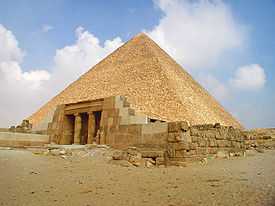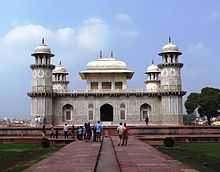Tomb
"Tombs" redirects here. For other uses, see Tombs (disambiguation).
"Sepulchre" redirects here. For other uses, see Sepulchre (disambiguation).
Tomb of Akbar in Akbar's Tomb

A type of tomb: a mausoleum in Père Lachaise Cemetery.

The Pyramid tomb of Khufu

Tombs and sarcophagi at Hierapolis
A tomb (from Greek: τύμβος tumbos)[1] is a repository for the remains of the dead. It is generally any structurally enclosed interment space or burial chamber, of varying sizes.
Overview
The word is used in a broad sense to encompass a number of such types of places of interment or, occasionally, burial, including:
- Architectural shrines – in Christianity, an architectural shrine above a saint's first place of burial, as opposed to a similar shrine on which stands a reliquary or feretory into which the saint's remains have been transferred
- Burial vaults – stone or brick-lined underground spaces for multiple burials, originally vaulted, often privately owned for specific family groups; usually beneath a religious building such as a church or in a churchyard or cemetery
- Church monuments – within a church (or tomb-style chests in a churchyard) may be places of interment, but this is unusual; they more commonly stand over the grave or burial vault rather than containing the actual body and are therefore not tombs
- Crypts – often, though not always, for interment; similar to burial vaults but usually for more general public interment
- Hypogeum tombs - stone-built underground structures for interment, such as the tombs of ancient Egypt
- Kokh – a rectangular rock-cut sloping space, running inward, like tunnels into rock, sufficiently high and wide to permit the admission of a corpse
- Martyria – Mausolea for the remains of martyrs, such as San Pietro in Montorio
- Mausolea (including ancient pyramids in some countries) – external free-standing structures, above ground, acting as both monument and place of interment, usually for individuals or family group
- Megalithic tombs (including Chamber tombs) – prehistoric places of interment, often for large communities, constructed of large stones and originally covered with an earthen mound
- Pillar tomb – a monumental grave. Its central feature is a single, prominent pillar or column, often made of stone.
- Rock-cut tombs – a form widespread in the ancient world, in which the tomb is not built but carved out of the rock and can be a free-standing building but is more commonly a cave, which may be extensive and may or may not have an elaborate facade.
- Sarcophagi – stone containers for bodies or coffins, often decorated and perhaps part of a monument; these may stand within religious buildings or greater tombs or mausolea
- Sepulchre – a cavernous rock-cut space for interment, generally in the Jewish or Christian faiths (cf. Holy Sepulchre)
- Samadhi – in India a tomb for a deceased saint that often has a larger building over it as a shrine
- Other forms of archaeological "tombs", such as ship burials
- Tumulus – (plural: tumuli) A mound of earth and stones raised over a grave or graves. Tumuli are also known as barrows, burial mounds, Hügelgräber or kurgans', and can be found throughout much of the world. A cairn (a mound of stones built for various purposes), might also be originally a tumulus. A long barrow is a long tumulus, usually for numbers of burials.
As indicated, tombs are generally located in or under religious buildings, such as churches, or in cemeteries or churchyards. However, they may also be found in catacombs, on private land or, in the case of early or pre-historic tombs, in what is today open landscape.
The tomb of Emperor Nintoku (the 16th Emperor of Japan) is the largest in the world by area. However, the Pyramid of Khufu in Egypt is the largest by volume.
See also
- Cadaver tomb
- Catacombs of Rome
- Church monuments
- Dartmoor kistvaens
- Death in Norse paganism
- English church monuments
- Funerary art
- Grave
- Ossuaries
- List of extant papal tombs
- List of mausolea
- List of non-extant papal tombs
- List of tombs and mausoleums
- Samadhi (shrine)
References
| Wikimedia Commons has media related to Tombs. |
